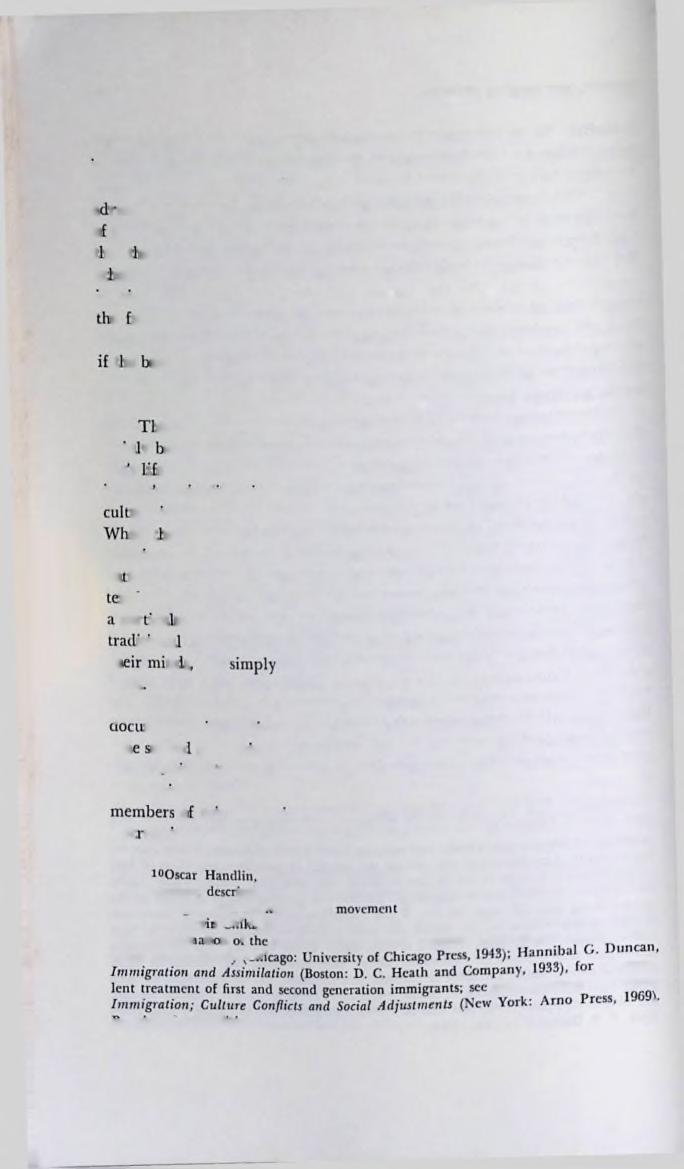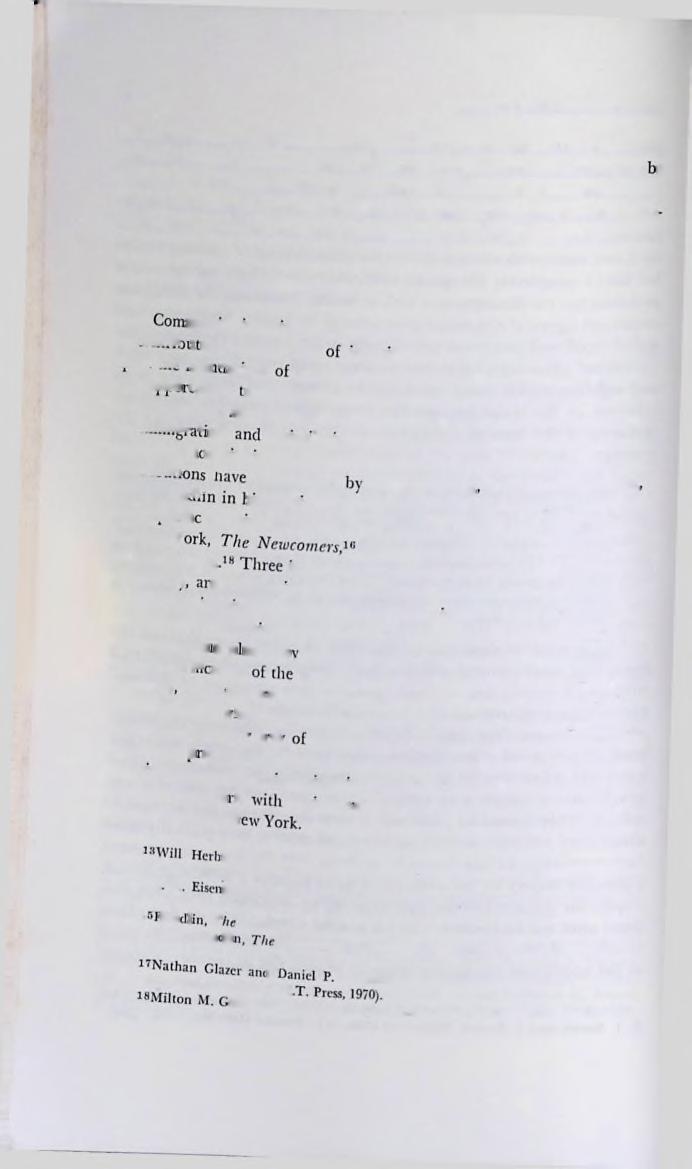
29 minute read
Cultural Pluralism
attitude toward the immigrant as one who would threaten the great achievements of the Anglo-Saxon, and therefore should be kept out of the United States, or compelled, when he came here, to adopt the ways of the traditional Americans (that is, the Anglo-Saxons) as soon as possible.
During and after World War I, this orientation shifted its emphasis. There appeared a willingness to accept the immigrant, accompanied by a determined effort to divest him of his traditional culture and get him to accept the American culture and way of life as quickly as possible. This has become known in sociology as the “Americanization” movement, and is commonly recognized as having been a mistake.5
While these theories were current, the concept of culture was being developed by anthropologists and sociologists. It began to appear noticeably in the immigrant literature in the study of Robert Park and Herbert Miller0 and in the highly esteemed classic of W. I. Thomas and F. Znaniecki.7
CULTURAL PLURALISM
The new understanding of the nature of culture shed light on the experience of immigrants coming from a different culture and facing pressures to adjust to the American way of life. It became clear that the attitudes and customs of the newcomers were not trivial, something that could be adopted or discarded like a winter coat. They were rooted in the deepest values of life, and had a meaning for the immigrant that was related to his answer to the questions “Why am I alive?” and “Where am I going?” Thus traits such as the Irishman’s apparent lack of thrift in spending for his family, the refusal of most immigrants to compete strongly against their fellow immigrants, and the unconcern of so many

against the admission of "inferior" races, attributing to this the decline of America. The racial theories were raised again at the time of the revision of the U.S. Immigration Law in 1952. Their influence was finally and fortunately ended with the Immigration Act of 19G5 which did away with the use of immigrant quotas based on nationality origins. •'‘Read Lewis, "Americanization," in the Encyclopedia of the Social Sciences, Edwin R. A. Seligman, ed., Vol. II (New York: The Macmillan Company, 1930), pp. 3335; Issac B. Berkson, Theories of Americanization (New York: Teachers College, Columbia University, 1920). Henry Pratt Fairchild, The Melting Pot Mistake (Boston: Little, Brown & Company, 1926), takes a somewhat modified position of "Americanization” which he modified still more in later works.
ORobert Park and Herbert A. Miller, Old IVorld Traits Transplanted (New York: Harper 8c Brothers, 1921). 7W. I. Thomas and F. Znaniecki, The Polish Peasant in Europe and America (Boston: Richard G. Badger, 1918). This has been recently reissued by Dover Publications, New York, 1958.
IDENTITY: THE ABIDING PROBLEM
immigrants with the making of money were not just the result of laziness or irresponsibility. Rather, when seen in the perspective of culture, they ''er.ef °.t®n manifestat'ons of a great sense of responsibility that expressed itsel differently from that of the Anglo-Saxon. They came from a sense
I t0 g*ve t0 one s relatives rather than save for oneself; from ove o cut ren as a value in themselves above abundant earthly posons, or rom loyalty to “one's own kind" rather than a desire for selfadvancement. levpk^'efSe CU'tura* tra‘ts influenced behavior not only on its deepest of sm’ii a so ln many of its more superficial aspects, such as the kind love n m i k WaS given: behavior at a wake or a wedding; the wav a fr' ®?nesS at a celebration, and respect for physical strength; the These we^ ii™ greeted’ a mea' served, or a type of clothing worn, the work f a interwoven in an outlook on life that gave meaning to "the sencp0,ta S bands and the love of a man’s heart; they gave life suDDortnfl ma er’ tbey were source of a man’s motivations and the
There?SatWfaCtion’This ™ ins culture. millions nf •°re’ .lt was one Aung to ask a man to become an American— quite anothlm"lIgrantS b°aSted that tbey wanted to be American- Xt waS of his life set * 10 b'm tbat be had t0 chscarc' the deepest values pattern of ideas??^1/1'6 tra,tS that gave life its meaninS- and adoPC a ship to the li ' r i UdeS’ and custorns which seemed to have no relationgrants had bernm ' a fatbers and grandfathers. In many cases the immiAmerica as tl i mericans precisely because they had conceived of values which thev^h '•'t'^ they wouId be free to live accordinS to the


viewpoint he] ?''S| d'C concePt °f cultural pluralism was evolved. This the immigrant36 T '°'ars t0 rec°gnize the importance of the culture of should exist in Ame° aCkn°"’ledge Ws loyakies’ values’ and customs to be called Amer’"361*62 tOgedler w*tb the other culture that had come
groups takes't/ Current literature on immigration or migrant •o imply a naive behXa! th'^' pluralism, for gTanted'S This is. nOt full-blown in an A he lmnlI8rant culture is going to continue will eventual! • merican environment. It is clearly recognized that it y give way to a form of life which is predominantly Amer-
t951); Ruth TuckBXtOim7/b 1"“,^e,alions (Boston: Houghton Mifflin Company, about the Mexicans of th 1 le (^cw York: Harcourt, Brace and Company, 1946), (Alberquerque: The Un' out*lwest’ Pauline Kibbc, Latin Americans in Texas Senior, and Rose Goldsen'°f ^CW Mexico Prcss- 1946); C. Wright Mills, Clarence 1950); and the well-knnt Ueit° Rican Journey (New York: Harper & Row, Publishers, (®*nglewood Cliffs, N.J • Prentice Brown and J. Roucek, One America

ican. But this occurs most harmoniously when the culture of the immigrant is respected, and given every opportunity to survive in the midst of American society.0
This recognition of the importance of culture led to a new insight into the nature and function of the immigrant community. When the Irish began to cluster into their predominantly Irish neighborhoods, and the Little Germanys, Little Italys, and Jewish neighborhoods became so conspicious during the last century and the early part of this century, a great deal of concern was aroused among the older Americans. In many cases, the immigrants transplanted to the streets of New York almost the exact pattern of social relationships which had characterized their native habitats. The visitor to one of these sections could easily imagine that he was in a strange land.
The phenomenon was criticized because many people thought that these immigrant communities would prevent the members from becoming American. The immigrants continued to speak and to read newspapers in their native language; they went to churches where customs and religious practice reproduced the customs of the old country; they courted, married, raised their children, and died in an island of a culture different from that of the United States. As long as this continued, it was feared that they would not be exposed to American customs and ideas, and thus would never adopt those cultural traits which the Anglo-Saxon prized so highly, and to which he attributed the greatness of the United States. The immigrant community was seen as a threat to the great traditions of America. It became obvious as time went on that this was an unreasonable fear. Consistently, as the immigrant population went from second to third generation, the inevitable social process worked itself out; the third generation child, no longer a product of a foreign culture, was predominantly American.
Nevertheless, there seemed to be some regret that this should take

°Not all that has been said in the name of cultural pluralism has been said wisely. Every society, according to its values and the forms of behavior by which those values are expressed, places limits on variations which it will encourage or even tolerate. For example. Americans will not tolerate the practice of polygamy, regardless of how deeply rooted it may be in the culture of people who come here. Neither would Americans tolerate the selection of a marriage partner that gave no choice to either of the parties being married. Note the very strong opposition on the mainland to consensual unions among Puerto Ricans, which has been a fairly widespread practice in their culture despite the constant teaching of Catholicism to the contrary. Not infrequently, sociologists will describe as a tolerable cultural trail something that persons of other religious beliefs would condemn as immoral and inhuman. Cf. the difference between Ruth Benedict’s consideration of culture traits in Patterns of Culture (Boston: Houghton Mifflin Company, 1961) and that of Father Andre Dupeyrat in Savage Papua (New York: E. P. Dutton Sc Co., Inc., 1954).
32
IDENTITY: THE ABIDING PROBLEM

so long to accomplish. There was a widespread conviction that, if the immigrants could mingle more closely with Americans and be taught the language sooner, the process of adopting American cultural ways would a vance more quickly. In some cases this was simply the rationalization o people who did not want the immigrants in the first place, but claimed t lat tiey would accept them “if they would only do things our way.” In ot ler cases, it evinced a sincere desire to hasten the process by which the immigrant would become "American.” It was generally recognized that e actor which seemed to impede more rapid adoption of American ways was the immigrant community. Consequently, it was argued that t ie onds of the immigrant community could be weakened, and immigrants more directly exposed to American influence, they would become part oftheAmerican wayof life much more quickly. iis last proposition has been strongly challenged in recent years, main y ecause of growing appreciation of the role of culture in everyone s i e. First, it has become clear that culture is the stabilizing factor in mans social life, giving it order and harmony. Any disintegration of a ure is attended by instability, insecurity, unrest, and even hostility, en t le common values which govern people’s actions, the common meanings that bind them together into a satisfying social unity, and the pa terns of behavior that everyone takes for granted are shaken or shatred, man’s social life becomes disorganized, perhaps chaotic. This was pai icu ar problem for people moving from a “folk” culture, or from a jIj ltlona form of social life which was not consciously represented in done "’»nt S ')Ut accepted from childhood as the “way things are , The effect of this breaking down of cultures has been abundantly
Th menteC' ln stuff*es of the second generation problem in America, in theTj00' ®enerat‘on are t'le people caught between two cultures. Born vet 6 niteC‘ ,<’tatcs°fforeign parents and raised at home in foreign ways, y continually instructed outside of the home in a different culture, the dist ° t^*S ®eneral*on can easily easily slip slip into into a cultural limbo.11 If this ess is so marked among the second generation, imagine how much

is an exwUcn: ^/le uprooted (Boston: Little, Brown and Company, 1951), sadness minelcd whhT°!! °' 'hC many aspcc,s of the uProolinS which P°inls UP the ii&e IrV rn- ae °P.e °f lhc °< P™P>c '« a new culture. for an examii C* r ' ll"^‘an °r American (New Haven: Yale University Press, 1943), Street Comer So'ci^tv trh- problcm among second generation Italians. See W. F. Whyte,
«.cpimt ot 1933 edition. an excelalso Lawrence G. Brown, '
IDENTITY: THE ABIDING PROBLEM
33

greater it would be among the first generation if they were deprived of the cultural surroundings of their traditional home, and the security that comes from the satisfaction of living among one’s own.
It has become clear that the immigrant community played an important role in creating a stable and orderly situation in which the transition from one culture to another could take place. Instead of allowing him to fall into a completely disorganized life, which would have created serious problems for the immigrant as well as for the Americans, the immigrant community gave the immigrant security as he faced a bewildering new world. It offered protection and support in the face of a challenge to his traditional values, and exercised a strong social control that gave order and stability to his social relations. As a result, and despite the stress inherent in the transition, the immigrant moved toward a gradual acceptance of the ways of a new culture. Maurice Davie summarized the process:
The essential functions of the immigrant community are to bridge the gap between the old country and the new, to prevent personal and social disorganization such as would result from too rapid change, and to interpret the American culture to the immigrant and prepare him to participate in it. . . . The newly arrived immigrant finds there a cultural haven without which he would be demoralized during the trying period of readjustment, and also assistance from the earlier arrivals in accommodating himself to the American scene.12
The result of these insights and discussions has been respect for the immigrant community as a form of transitional society which has enabled millions of immigrants to move gradually into acceptance of predominantly American attitudes and patterns of behavior.
In summary, the theory of cultural pluralism relating to the adjustment of people to a new culture would seem to suggest the following: No strong effort should be made to disorganize the community which immigrants or migrants may form as they move into the area of a new culture. They should be permitted to form communities of their own in which they will have security, stability, and order as they gradually learn American ways. Efforts should be made to help the immigrant preserve a genuine respect for his own culture as he acquires a knowledge of and respect for the new culture. Opportunities for association with older residents must not be blocked. The job and the school will be the first places to offer such associations. The neighborhood will become another place as the immigrant community begins to weaken and its members disperse.

IZMauricc R. Davie, "Our Vanishing Minorities," in One America (3rd ed.), eds. F. J. Brown and J. Roucek (Englewood Cliffs, N.J.: Prentice-Hall, Inc., 1962), p. 547.
34
IDENTITY: THE ABIDING PROBLEM
In this situation, the immigrant community will not shut its members oil from gradual integration with their new culture; neither will it e blocked off in a ghetto-like segregation by the resistance of older residents. This is an ideal pattern which will never be wholly carried out in prac tice, but ithas been the policy predominating in the last generation.
CONTEMPORARY THEORY

so conirii mUnity ls a v ‘ta* factor in immigrant assimilation because it is anart ths r* °r\ t0 tbe Sense *<'en,*ty °f migrating peoples. To take and onnn r°UI- atlOns a Person’s identity before he has had the time serious threT'^l -° deVe'°P a new identity in a new culture can be a on inlm;m.a.tt0 lls whole Personality. Consequently, the recent literature problem oU 1°° ass‘m*'at‘on centers its attention directly on the contrihm; * e.ntlty *n tbe experience of immigrants. The most significant Oscar Hanm- h**" made Wi“ Herherg” «• N. Eisenstadt ” more specif) '*S C’ass*c on tbe subject, The Uprooted,15 and in his in New y exa™nation °f the experience of Blacks and Puerto Ricans Milton Gordon N’ G'aZer and D' Moynihan,” and of identity ■ imPortant developments, related to the problem tance of the 6 eVldent ’n these writings: (I) reemphasis on the importhepro^7:^a":rmunit^stheb-sf- a sense of identity in the central r .trans'l‘on ^om one culture to another; (2) recognition of and (3) ciar;c° 6-P a^Cd b' religion as the basis of social identification; in reality ther'31101' f>rocess °f assimilation in the recognition that, assimilation fa6 ""j6. l"° Processes, not one. There is a process of cultural ship with • • their y " llch newcomers establish a practical working relationwhich the r p ' "l |ll<!" o rem "a^ ’de of identity ’ and a Process and community of is social assimilation the crucial issue. in An examination of ceptual framew the i? ma*n P0lnts *n this literature will provide the conPuerto Ricans ht°N "*’*cb "e can anafyze the experience of the

Company, Inc., 1955^' Pro,estant, Catholic, Jew (Garden City, N.Y.: Doubleday & 1955).
1-1^ N '
stadt, The Absorption of Immigrants (New York: The Free Press, ioolnarIHanTir C//Jr00'frf’^ri'1959). Atewcomerj (Cambridge. Mass.: Harvard University Press, (Cambridge, Mass.: Harvard\n Mtrynihsui, Beyond the Melting Pot (2nd ed.) sity Press, 1964). or<*on. Assimilation in American Life (New York: Oxford Univer-
Will Herberg

Herberg’s study is not formally a study of migration, but of religion. He was struck by the phenomenon of an increasing interest in and emphasis on religion in the United States concurrent with a noticeable increase in secularism. Herberg set out to explain the religiousness of a secularist people and the secularism of a religious people. However, in seeking light on these questions, he became involved in an extensive treatise on migration and assimilation, and his book is now a standard work on the subject of the assimilation of immigrants in the United States. The discussion of both religion and assimilation is focused on the problem of identification. There is one problem which Herberg considers to be central for all immigrants. As strangers in a strange world, how do they answer the questions: “Where are we?” and "What are we?” Briefly, Herberg concludes that religion has become the basis of social identification for third generation Americans.
The first generation become aware of themselves as strangers, and identify themselves by referring to the world from which they came. As Herberg says, they are conscious of their ethnic identity, thinking of themselves as Irish, French, Scotch, Polish, or Italian in a way in which they had never thought in their country of origin. The second generation, in an effort to identify themselves as Americans, tend to deemphasize their ethnic origins. They break away from the way of life of their parents, and from language, religion, and behavior patterns associated with the culture from which their parents came. The third generation, confident now of their identity as Americans, look for some symbol which would give them a specific identity. The one feature of the old world culture which they can revive, and which can be legitimately manifested in American life, is the religious identity of their forebears. Thus they revive their interest in the religion of their grandparents, return to practice of it with a decidedly American style, and use their religious affiliation and the pursuit of religious interests as the basis for their specific identity as Protestant, Catholic, or Jewish Americans.
Herberg’s thesis has a number of significant implications for the theory of assimilation. Like most contemporary theories, it takes for granted the three generation hypothesis: by the third generation, the immigrant group has by and large adopted a common American way of life. Second, he recognizes the question of identity as the central problem of newcomers. Finally, he finds that a strong sense of community based on religious identification plays a crucial role in the process of assimilation.
Herberg published his book in 1955. In the intervening years the role of religion in American life has changed significantly. The radical

IDENTITY: THE ABIDING PROBLEM
changes in religious life, and in the social and cultural life of the nation, would require substantial modifications of Herberg’s theory. Nevertheless, identity as the central problem remains the major issue in the immigrant experience.
Nathan Glazer and Daniel P. Moynihan

In their study of the ethnic and racial groups of New York City, Nathan
Glazer and Daniel P. Moynihan present a theory which provides a new insight into the question of identity. The authors acknowledge, as do most contemporary scholars, that the need for identification results in the effort by immigrants to retain their ethnic identity. Their concern is to iscover what happens to ethnic identity in the process of assimilation, ost previous studies of assimilation indicated that the immigrants had become an integral part of American society by the time of the third generation. The symbol of the “melting pot" has been used to describe t at unity (admitting of some differences) which is the present state of those who constitute the third or later generation of migrating people. > azer and Moynihan simply deny that the melting pot ever melted. As iey escribe it, the quest for identity takes a peculiar shift. In the process assimilation, identity on the basis of national origin tends to weaken; is no longer feasible for people to identify themselves by language, culture or customs. Identification tends to rest more on common interests wuci ecome related to ethnic background rather than constituting an inic rackground themselves. "The ethnic groups of New York are also interest groups.’’10
Glazer and Moynihan find that "the specific pattern of ethnic difrentiation ... in every generation is created by specific events.”20 They e ieve that four specific events have provoked the crystallizing of ethnic oyalties: Nazi persecution and the establishment of Israel have been a ocus o identification for Jews; the reemergence of the Catholic school controversy has done the same for Catholics; race is the focus of identication of the Negro; the experience of migration serves this purpose for uerto Ricans. Around these four issues or experiences, a pattern of loyalties has developed which has resulted in a differentiation of New York into these four main groups. These groups, forming around particular inteiests, are the persistent ethnic groups of the present generation.
The question that emerges from the analysis of Glazer and Moym lan is. What of the future?” If common interests replace nationality ac ground as the basis for ethnic identity, how is this likely to affect ao/tid'1 a2gIMoynihan’ Bey°nii th‘ Melting Pot, op. oil., p. 17.


the city or the nation? In other words, according to Glazer and Moynihan, it appears that the problem of cultural assimilation has been successfully met—people of diverse cultural backgrounds have been sufficiently integrated into a common American culture. Now a different type of problem presents itself, that of accommodating conflicting interests in one reasonably harmonious society. Conflicting interests have always been troublesome in the United States, and political institutions have been formed in order to give suitable representation to conflicting interest groups without endangering the common welfare. However, the interest groups which Glazer and Moynihan define as contemporary have a particular quality. Their interests crystallize around the basic and elemental loyalties which are characteristic of such fundamental human communities as an ethnic group. This gives the interest group a highly charged quality and an intense emotional tone. It is the division of interest groups on this level with which Glazer and Moynihan are concerned as a possible source of difficulty in the future:
Religion and race seem to define the major groups into which American society is evolving as the specifically national aspect of ethnicity declines.
In our large American cities, four major groups emerge: Catholics, Jews, white Protestants, and Negroes. . . . Religion and race define the next stage in the evolution of the American peoples. But the American nationality is still forming: its processes are mysterious, and the final form, if there is ever to be a final form, is as yet unknown.21
What happened, as Glazer and Moynihan explain it, is that the variety of interests which ordinarily mark a nation’s life have become related in the American experience to the problem of identity. They agree with Herberg’s view that as Americans come closer to sharing a common culture, they seek a specific identity, and the basis of this identity tends to be religious. But they add another factor, indicated by the four specific events cited earlier. Interests then tend to converge around this basic identity. This is the new phenomenon in the contemporary United States, and coping with it successfully will hopefully be one of the creative achievements of the future.
Glazer and Moynihan would expect the Puerto Ricans to follow the path of previous immigrant groups, identify with the interests of Catholics, and thus take their place in the mainstream of the nation’s life. But they recognize that there are many obstacles to this development. The class differences between Puerto Ricans and other Catholics are making it difficult for the Puerto Ricans to establish themselves solidly with other Catholic groups. Furthermore, there are so many uncertainties

21Ibid„ pp. 314, 315.
38
about the relationship of the Catholic Church to the serve as a will be explored in Chapter Eight) that religion may basis of identity. In addition, the Puerto Ricans ar° ajvancement depressed economic condition as the Blacks, an econ them have is particularly difficult and unpredictable. Finally, ma jn 1970, to cope with the problem of color. In a revised edition Moynihan seven years after the original edition of their book, azei of the find the Puerto Ricans at the lowest social and econom^^^^ the footcity’s population, still struggling against great odds to es holds which will enable them to move strongly into the ci y
Milton Gordon

The latest extensive study of cultural assimilation (by i 1 a-jabie of the also the most complete and competent analysis now • nature of nature of assimilation. The book consists of a statemen America”y assimilation, a review of various theories of assimilatioi • — ftjon> with life, and a presentation of Gordon’s own analysis o assi America” indications of its implication for practical policy and action mcieiy- . , ' 1 --~iproblem of
One of the major foci of Gordon’s discussion he j is by identity, the process whereby a person defines for himse^ prifflary, becoming increasingly aware of his relationship t , basisbasis forf°r face-to-face interaction. Beyond the range of the farm y. of commoncommon identity is the ethnic group, which is based on a num J and which which bonds such as values, religion, historical experiences, anc r. one, of gives to a large number of individuals the deep sense of ° beingotber tradibeing what Gordon calls "a people” distinct from those wi win ^nc. ions, historical experiences, or values. Gordon specifies ti groups ons for the ethnic group: "... it provides a patterned net' jmary relard institutions which allows an individual to confine ns P_ tbc life ionships to his own ethnic groups throughout all die stag national cycle. Its third functional characteristic is that it re racts oWn cultural patterns of behavior and values through the Prism of life, cultural heritage.’’22 The ethnic group is the carrier of t ie group or culture, of its members. Consequently, whenever t ie ” rnembers weakens or changes, there will be a problem of identity. ' m ethnic of an ethnic group move into a society dominated by ano ^cwcomers group, and the contact raises a challenge as to whether t re absorbeci will continue to live according to their traditional culture or x into the new culture, the problem of identity becomes acute.

—Gordon, Assimilation in American Life, op. cit., p. 38.

One of Gordon’s significant contributions is his analysis of the relationships of the ethnic group to social class. The ethnic group does not always exhaust a person's social experience. In many cases, societal structures develop based on power, wealth or prestige in which "superiority and inferiority are reciprocally ascribed.”23 Particularly in the United States, which is the clearest example of an open class society, this kind of a class structure has developed distinct from the ethnic identities of many different groups; the same ethnic group may have members of many different classes. Therefore, a new kind of identity has developed, on the basis of social class. The ethnic identity is based on historical traditions, background, and a person’s relationship to earlier history, thus giving him historical identity. His identity in terms of class tends to depend on his educational and occupational level, on day-to-day contacts in business, political activity, and active social life. This gives a person what Gordon calls his identity of social participation. The socal class develops its own values, patterns of relationships, and institutions. In other words, it takes on the characteristics of a culture of its own. In a society like that of the United States, the problem of identity is complicated by this relationship between ethnic identity and class identity. Gordon seeks to state this relationship in a number of hypotheses: (I) . . . With regard to cultural behavior, differences of social class are more important and decisive than differences of ethnic group. ... (2) With regard to social participation in primary groups and primary relationships, people tend to confine these within their own social class segment of their own ethnic group. ... (3) The question of group identification must be dealt with by distinguishing two types of such identification from one another—one the sense of peoplehood . . . the other a sense of being truly congenial with only a social class segment of that "people."2!
The process of assimilation and the process of establishing identity must be examined in relation to these two factors of ethnic group and social class. The term that Gordon uses to identify this is “ethclass.” As Gordon explains it, a middle class Puerto Rican probably feels a closer identity with a middle class Italian or Englishman than he feels with a lower class Puerto Rican; and a poor Italian or Black or Jewish person would probably feel closer to a poor Puerto Rican than to a middle class Italian or Black or Jewish person. Barring the factor of language, Gordon thinks that middle class people of various cultures share similar values and attitudes which are distinct from the ones they share with poor people of their own ethnic group. Therefore, in the analysis of Puerto Rican experience, it will be important to indicate the class levels and class rela-

-3/bid., p. 40. Ulbid., p. 52.
TABLE 3-1
THE ASSIMILATION VARIABLES
Subprocess or Condition
Change of cultural patterns to those of host society Large-scale entrance into cliques, clubs, and institutions of host society, on primary group level Large-scale intermarriage Development of sense of pcoplehood based exclusively on host society Absence ofprejudice
Absence of discrimination
Absence of value and power conflict
Type or Stage of Assimilation
Cultural or behavioral assimilation Structural assimilation
Special Term
Acculturation
None
Marital assimilation Identificational assimilation
Attitude receptional assimilation Behavior receptional assimilation Civic assimilation Amalgamation None
None
None
None

VnUv “A’?ill°" M' Gordon’ Assimilation in American Life (New York: Oxford University Press, 1904), p. 71.

tionships Of the Puerto Ricans in New York City, as well as their ethnic ground. In other words, the ethclass of the Puerto Ricans is a neces- y consideration in the analysis of their assimilation. oidon actually distinguishes the process of assimilation into seven cesses related to seven stages. The first of these is a process of cultural ssinn ation in which the newcomers accommodate themselves to the basic *es and behavior patterns of their new society, at least to a point which permits them to function reasonably well in it. The second is a process tructural assimilation by which the newcomers accommodate and fa acCePled *nt0 the primary groups of the new society, interact on a ^ace to- ace basis, and feel themselves identified with members of the new ety. In other words, newcomers can live in a society with a distinct lure and function effectively in it while their day-to-day lives remain quite isolated from primary relationships with members of the host soci,°r<'on presents all seven stages in the process of assimilation in a paradigm which is reproduced in Table 3-1. in view of this analysis, Gordon states a few simple principles to summarize his theory:
IDENTITY: THE ABIDING PROBLEM
41
1. Cultural assimilation is usually the first type to occur. 2. It is possible that cultural assimilation could occur without any of the other types occurring. In fact, the situation of “cultural assimilation only” may continue indefinitely. 3. Once structural assimilation has occurred, all other types naturally follow.
With the use of his scheme, Gordon analyzes the experience of the various ethnic groups in the United States. He concludes that the resulting situation is not really one of cultural pluralism, since all the ethnic groups have adapted themselves to an increasing degree to the dominant cultural themes of the American way of life, strongly influenced by the Protestant, Anglo-Saxon tradition. The pluralism that has emerged is a structural pluralism, the formation of primary, face-to-face interacting groups, ranging over all social classes, in which the fundamental basis for identity is religion (Protestant, Catholic, Jew) or race.
Gordon arrives at conclusions similar to those of Herberg and Glazer and Moynihan, although his theory is much more developed and his analysis much more refined. It is possible to use his analytical model to determine what level of assimilation a particular group has reached, and how the process of assimilation is taking place at a given place or time.

Summary of Contemporary Theory

The problem of identity emerges from all these studies as the central problem of a social group migrating to a new culture area. The initial cultural assimilation can take take place place to to some degree without the newcomers losing their sense of of identity identity based based on history, traditions, and language. They may become extensively adapted to the new culture and develop a way of life of their own in the new culture. Structurally, they may retain an identity even though they have lost their traditional way of life, or they may seek a new identity by being absorbed into the primary groups of the new culture. This admits of degrees, and reaches its culmination in the acceptance of courtship and marriage between members of what had been culturally disparate groups. In approaching an analysis of the experience of Puerto Ricans, a conceptual framework can be developed out of the studies which have just been analyzed.
Cultural assimilation is the first and essential adjustment of newcomers. Therefore, it will be evident in the experience of the Puerto Ricans. Their progress may be compared with other groups in the speed and extent to which cultural assimilation has taken place. This would involve knowledge of the English language in areas where it is essential to their life in New York; ability to seek work and perform it satisfac-



